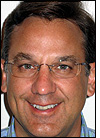The key card has become a ubiquitous accoutrement of the white-collar worker. Most corporate and government offices distribute these RFID-enabled cards to employees or other authorized visitors, who use them to gain access to offices or buildings, while others must check in manually. Each proximity card transmits a unique ID number that is then written to a database that provides a record of every person entering a secure facility. But if employees hold doors for one another, then no records are kept for those who enter without showing the card.
What’s more, unauthorized parties can enter this way as well. For this reason, security experts consider holding doors open a breach of security rather than an act of kindness. What if the person to whom you’ve granted entrance turns out to be a terrorist? What if he’s armed? What if he’s out to break into the local area network (LAN) to steal data?
It was a phone call from an insurance agency, however—one grappling with false insurance claims resulting from the Sept. 11, 2001, attacks on the World Trade Center—that led executives at American Barcode and RFID to start researching a new approach to security. This Phoenix-based firm sells bar-code networking systems, as well as bar-code and RFID-enabled loyalty and proximity cards.
“AIG Insurance asked us if there’s a way to know, definitively, who is in a building at a specific time [to combat false insurance claims from people who lie about being in a building when disaster strikes], and they wanted to be able to write that data to a Web server so it would not be saved locally,” says Ted Morgan, director of card solutions at American Barcode and RFID.
After five years of development, American Barcode and RFID has announced the Tetragate platform, combining RFID-enabled ID cards with video cameras and facial-recognition software. Tetragate is designed to enable companies to monitor and authenticate thousands of people as they enter secure buildings. When American Barcode first began investigating building security, says Morgan, “RFID was just starting to take off, and face mapping was really unheard of. But since 9-11, we kept talking about it, and Tetragate is the result.”
Tetragate has a two-prong approach to addressing the security holes generated when people enter access-controlled buildings without presenting a proximity card—such as when someone holds a door open for them. First, Tetragate’s RFID-enabled ID cards contain ultrahigh-frequency (UHF) RFID inlays, rather than the high-frequency (HF) or low frequency (LF) inlays used in key cards for access-control systems. The UHF inlay, provided by Symbol and compliant with the EPCglobal Gen 2 protocol, has a read range of up to 25 feet, whereas HF and LF key cards must be held within a few inches of readers. Thus, if someone holds a door open for an employee, allowing that person to enter without presenting a key card to the access-control reader, the Tetragate reader installed at the doorway will sense the UHF Tetragate card, even from inside a brief case or purse. Second, Tetragate uses networked digital facial-recognition cameras to authenticate each person entering a secure area.
The facial-recognition software, provided by Fulcrum Biometrics, collects video images from Infinova cameras installed around an entrance. According to Mike Stryczek, president of American Barcode and RFID, the cameras can photograph individuals from as far as 40 to 60 feet from the entrance. The software, meanwhile, can extract from the crowd thousands of faces per second, comparing each one with a database of facial images taken whenever personnel badges are issued.
If the software can’t find a match for a face in its database, it e-mails an alert to building security personnel, attaching the captured image. How security officers then handle such exceptions, Stryczek says, depends on the business rules in place at a particular company. For instance, the protocol might be for a security guard to locate any unauthorized persons in the building lobby and ask if they need assistance, or whom they are visiting.
Stryczek notes that Tetragate could be used not only to track unauthorized visitors and monitor employees entering the workplace, but also to determine which company assets, such as laptop computers, they are carrying. To do so, the company would first need to affix EPC Gen 2 UHF tags to those assets.
American Barcode and RFID partnered with epcSolutions to link the Fulcom facial-recognition software with the data pulled form the RFID interrogators. It is presently using Zebra Technology‘s RFID card printer-encoders to produce the RFID-enabled ID cards.
Thus far, the Tetragate system has been tested only in lab facilities—it has not yet been used in a real-world environment. Still, Stryczek says his firm is in early discussions with a number of interested organizations in the Southwest, including government offices, military facilities and a professional sports arena. He notes that the latter’s owners are interested in using the system to track the movement of people in employee-only areas.
Pricing for a basic package, the company says—which includes RFID-enabled ID cards, a Zebra card printer-encoder, a Symbol Gen 2 interrogator, an Infinova camera and all the necessary software—starts at $25,000. The Tetragate platform is not presently designed for integration with building access-control systems, so the UHF card cannot be used as a key card. That means companies deploying the Tetragate system would need to use an HF or LF key card system for access control and the Tetragate UHF cards for ID.
According to Stryczek, companies may also choose to deploy just the RFID-enabled personnel badges, without the Infinova and Fulcom facial-recognition software, at a much lower cost. Before deploying the system, however, American Barcode and RFID says it must perform a site assessment, which costs $8,000. The Tetragate platform is currently available.


